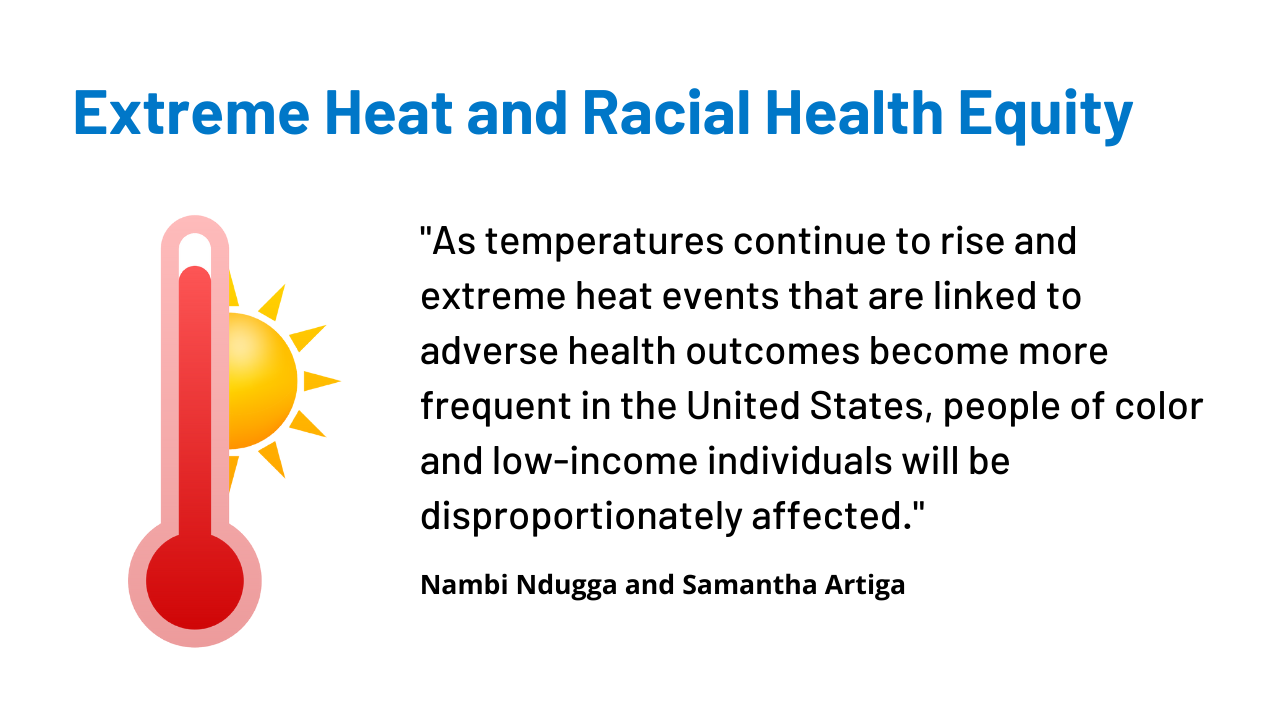Amidst the ravages of a global pandemic, the world recently experienced the hottest month (July) ever recorded. During the summer, the United States reported record extreme heat events across the country. Heat exposure poses a range of health risks that lead to fatalities and illnesses each year, including respiratory illnesses, heat exhaustion, heatstroke, and heat-related mortality. Studies also find exposure to heat is associated with increased risk of hospitalization, particularly among older individuals, as well as increased risk of death. According to the Centers for Disease Control and Prevention (CDC), more than 65,000 people visit the emergency room for heat-related stress per year, and approximately 702 die from heat exposure.
While extreme heat and other hazardous weather events have implications for everyone, growing research shows that they disproportionately affect low-income people and people of color due to underlying social inequities and structural discrimination. From 2005 to 2015, the rates of emergency department visits for heat-related illnesses increased by 67% for African Americans, 63% for Hispanic people, 53% for Asian Americans, and 27% for White people. CDC data also show that between 2004 to 2018, American Indian and Alaska Native people had the highest rates of heat-related death, followed by Black people. With climate change contributing to rising temperatures and other climate-related events, understanding disparities in these risks and their health implications is of growing importance.
One factor that contributes to disparities in heat exposure is residential segregation. Historic housing policies, including redlining, resulted in residential segregation that pushed many low-income people and people of color into urban neighborhoods with fewer resources and more limited opportunities for development and advancement, issues that have been exacerbated by disinvestment in these areas over time. This residential segregation not only contributes to inequities across a range of social and economic factors that negatively affect health, but growing research also shows that it leads to people of color incurring more environmental health risks, including higher levels of exposure to pollution, hazardous waste, and urban heat.
Research shows that land surface temperatures in historically redlined areas are warmer than in non-redlined areas, with the study authors concluding that “current maps of intra-urban heat echo the legacy of past planning policies” and that global climate change may exacerbate existing, historically-codified inequities in the U.S. Similarly, a study recently published in Nature found the average person of color was more likely to live in a census tract with higher summer daytime surface urban heat island intensity compared to White people in all but 6 of the 175 largest urbanized areas in the U.S. The study also found a similar pattern for people living in households with income below the poverty line relative to those with incomes at least two times the poverty level. In some cases, the differences in temperature between the two groups can be as large as 20 degrees Fahrenheit.
Beyond differences in residential patterns, other underlying inequities also contribute to disparities in heat exposure and heat-related health risks. People of color are disproportionately exposed to extreme heat through their occupations. For example, noncitizen and Latino migrant workers make up 50% and 75% of agricultural workers in the United States, respectively, who are about 20 times more likely to die from heat-related illnesses compared to other US-based workers. Low-income households, particularly those located in areas with higher shares of people of color also face high energy burdens which may contribute to difficult trade-offs between paying their energy bills to cool their homes or paying for other household necessities.
The threats associated with extreme heat have been compounded during the COVID-19 pandemic, especially for people of color and low-income people. In an effort to curtail the spread of the virus and adhere to stay-at-home policies, many people stayed at home and avoided formal and informal cooling centers (large, air-conditioned public spaces) such as pools, splash pads, grocery stores, libraries, and others. Many are unable to maintain adequate cooling temperatures at home due to inaccessibility to air conditioning or financial constraints, exacerbated by decreased household incomes because of pandemic-related unemployment and other factors. Black and Hispanic households have been particularly affected, as they have been more likely to experience energy insecurity—receiving disconnection notices or having utility services disconnected— during the pandemic, compared to their White counterparts.
The pandemic, as well as the recent destruction caused by Hurricane Ida, have highlighted how underlying structural and systemic inequities leave people of color and low-income individuals at increased risk in the face of a crisis. Similarly, as temperatures continue to rise and extreme heat events that are linked to adverse health outcomes become more frequent in the United States, people of color and low-income individuals will be disproportionately affected. Together these findings point to the importance of addressing underlying social and economic inequities that drive these disparities to mitigate the impacts of weather and environmental hazards, climate change, and other emergencies, as well as to improve overall health and well-being.

